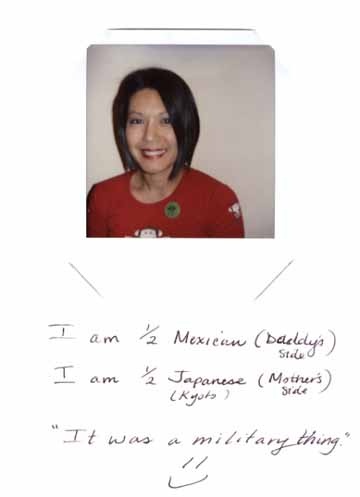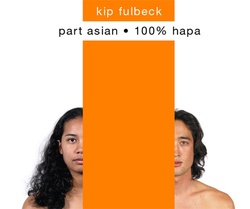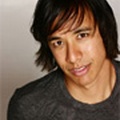kip fulbeck: part asian, 100% hapa is an exhibition of portraits by artist and filmmaker Kip Fulbeck. The exhibition is showing at the 7th Floor Gallery at A/P/A Institute in New York City through May 30, 2008. For more information visit the exhibition Web site.
Discover Nikkei asked Kip to share his views on the exhibition and its impact, and he responded with a list of frequently asked questions along with his answers. -.ed
How did you come up with the idea for The Hapa Project?
The idea actually came to me as a kid, sometime in elementary school. I just thought it would have been cool to know there were other people around going through what I was going through, other people who couldn’t answer the “check one box only” question honestly. Since then, I had always wanted to produce a book and project like this, but never got around to actually doing it because it seemed like so much work and organization (the latter of which is not my strong point). Sometime in my 30’s, I mentioned it to a girlfriend of mine and she convinced me to do it. It was a ton of work, but definitely a work of love.
What surprised you about doing this project?
Many things surprised me about this project. The first is the way it’s been embraced. I had no idea it would take off the way it has, and I’m very thankful for the wonderful outpouring of support I’ve received from so many people. Every day I get emails from people who have found the book or seen the show, telling me it’s the first time they actually felt part of something – be that a shared identity of not fitting in, some sort of intangible community, or even a discussion. For many of us, when it came to discussing ethnic identity, we were never offered a seat at the table.
A lot of my career as an artist has come from being in the right place at the right time, or simply being the first person to do something, or both. I didn’t direct Banana Split with the idea of making the first Hapa film; I was just trying to tell my story. And when you watch it, it’s about so much more than Hapa identity … dating politics, masculinity, alcoholism, pop culture ... But that’s the same way I look at identity exploration – it’s more than just “I am _______. Next question?” Which is why The Hapa Project is more than a project about race or ethnicity. It’s a project about identity.
How did you pick who went in the book?
I originally culled 250 portraits from the original 1200 I shot. We (Chronicle Books and I) planned to use one person per page including their statement. But when I started to lay it out, it seemed much too visually compressed. The pages didn’t have any breathing room and the book felt too tight. So artistically I made the call to cut the number by 50% and put one person/one statement per every two pages. Trouble was, I was too attached to each image to cut any more – every single photograph represented a relationship to me, albeit often a short one, but a valid and real experience nonetheless. Adding to that, I actually found every person’s image and statement interesting on their own terms. It was hard enough cutting down to 250 and now I was supposed kill off half more of my kids? So I threw up my hands and told my editor, “I can’t do it. You figure it out how to edit it down.”
Eventually, what happened was we laid out 250 images across all these tables at Chronicle Books in San Francisco. Then, three editors and myself walked around with 30 little stick-on red dots each, placing them on each image we chose individually. It was a bit surreal … quiet and thoughtful, everyone in their own little worlds picking images. Until after about 15 minutes, my editor Bridget exclaimed, “I have a confession to make. I haven’t picked one hot girl!”
The rest of us (three men) stopped, then admitted that we hadn’t picked any hot girls yet either. It turned out we were all being careful of not making this the “hot” Hapa book, the hybrid-vigor-all-Hapas-look-like-Devon-Aoki book. So we laughed at our collective vigilance and decided to pick a couple hot girls to include.
How did you pick the cover? Why did you put the girl on the back and spine?
Picking the cover was really difficult. For one, when it comes to publishing, authors rarely (if ever) get to choose their book covers. Sometimes they don’t even get to pick their own author photo! I was fortunate that not only did I get to give serious input on the cover, I got to oversee the entire book’s interior design – font, spacing, layout, etc.
The real question was how do you pick one image to represent a book about diversity? How could one image sum it up? I tried several different designs with various faces, vignettes … everything but composite morphs (because I didn’t want it to look like that early 90’s Time Magazine or some Michael Jackson video). But my editor kept coming back to me with, “This looks great, but it doesn’t match the rest of the book.” And she was right. The book is clean and pure in its simplicity of design, format, perhaps even its message, and the cover needed to represent this. A single image can’t represent the diversity of Hapas, nor should it even try. It can just give a sample of my photographic and design styles.
So I decided to go with the first person I ever photographed, my former research assistant Jenn. It made sense to me. That trip of the shutter was the beginning of the project, so why not put her on the cover?
But several editors objected to this choice for an interesting reason – they felt she was too pretty. Initially, this took me by surprise. But I gave the argument a lot of thought and ended up using my friend and surfing buddy Shane for the cover and put Jenn on the back and spine. I think it works well and I like having a guy on the cover actually. The funny thing is, dozens of people have asked if it’s me on the cover – like I would put myself on the front of my own book like Oprah on O Magazine! A lot of people also ask if it’s Sean Lennon, even though none of us look remotely alike.
How did you find subjects for your book?
It was actually very easy. They were all volunteers from around the country. I’d just post a shoot on the website and people would come out of the woodwork. I did a shoot in San Francisco that was scheduled from 6:00-8:00. I got there at 5:00 to set up and there were thirty people waiting outside. I think when you’ve gone your whole life not fitting into these boxes, you’ve got a lot to say about it.
Isn’t that _______ in there? Why didn’t you identify the celebrities?
I was very adamant about not identifying anyone in the book, which is why the names are listed alphabetically at the back. Part of that is safety for the children, but most of it is because I wanted participants to have as blank a slate as possible to work with, to not be burdened by any pre-existing identifiers. It’s interesting with celebrities, because celebrities without their gear – their look or environment or entourage – don’t look like celebrities. They look like people. And that’s what I wanted. I could photograph Cher this way and she’d look like a regular person.

Add photo to your photo to The Hapa Collection in the Nikkei Album on Discover Nikkei. Go to the following link to find out how: http://www.discovernikkei.org/nikkeialbum/en/node/6926
Why aren’t the subjects smiling? Why did you have them remove their glasses and jewelry? Why are they naked?
This is also about starting with as blank a slate as possible. Every way we present ourselves visually, from our style to our glasses to our jewelry to our expression, is a way of identifying ourselves culturally and socially. And I wanted people to just be who they were at their base, to be as much as possible at their essence. (On a side note, this can be very threatening to some people who put a lot of stake into their created physicality … a couple celebrities agreed to be photographed, then pulled out.)
Another point I should mention is that every participant not only got to write their statement the way they wanted to, they also got to pick their own image. A camera is a tremendously powerful tool and the power dynamic between photographer and subject is palpable. For this reason, I wanted to give some of the power back to the subjects. It was never going to be completely democratic – it is, after all, my concept, my project, and my design – but there are some strategies you can employ to make it less unilateral. Everyone got to see their image and choose to keep it or erase it and shoot again. I shot one woman over twenty times. And the bizarre thing about it was I couldn’t tell a difference between any of her shots. They all looked exactly the same to me! But she kept freaking out, “Oh my god! My eyebrow! Erase it!” or “Oh my god! My chin! Erase it!” I guess some people spend more time in front of the mirror than others.
The naked question is always a funny one because they’re not naked. You’re seeing them from the collarbone up, much less than you’d see of someone at the beach or even at the mall sometimes. Plus, when I shot them they’re just usually just wearing spaghetti straps they pull off their shoulders.
Where did you shoot?
I shot all over California (Los Angeles, Orange County, San Diego, Santa Barbara, San Jose, San Francisco), as well as Honolulu, Waimanalo, Chicago, Syracuse, Manhattan, and Madison, Wisconsin. Because of funding, I basically shot wherever I was being brought out to speak.
Were there any other patterns that emerged?
Easily, at least two-thirds of the participants were part Japanese American, maybe more. I wasn’t able to photograph one person who was part Cambodian or Hmong before the book went to press. Also, the overwhelming majority of the volunteers were female. At some shoots the ration of women to men would be 20:1. It’s the same in the identity seminars I teach at the University of California, Santa Barbara. Women are much more open and interested in talking about their identity than men in this country. I have a lot of theories about why that is.
© 2008 Kip Fulbeck




